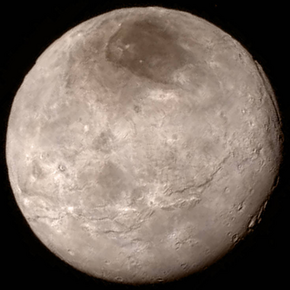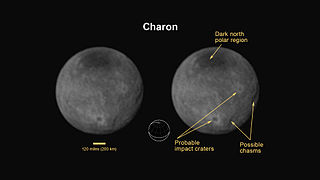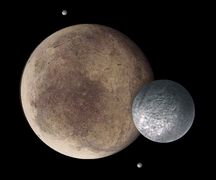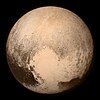Haron
| Haron[1] | |
|---|---|
| Otkriće | |
| Otkrio | Džejms Kristi |
| Datum otkrića | 22. juna 1978 |
| Karakteristike orbite | |
| Srednji poluprečnik orbite | 24.856±0.001[2] km |
| Apoapsis | 19.572,8[3] km |
| Ekcentricitet | 0,000000 ± 0,000070[3] |
| Period revolucije | 6,3872304 ± 0,0000011[3] |
| Prosečna brzina revolucije | 6,38725 dana |
| Nagib | 0,001° (Äquatorebene)[4] |
| Fizičke karakteristike | |
| Srednji poluprečnik | 1.208,0 ± 3,0 km |
| Površina | 4.560.000 km² |
| Masa | 1.52±0.06×1021[5][6] kg |
| Zapremina | 9.027×108 km³ km³ |
| Gustina | 1.65±0.06 g/cm³ |
| Gravitacija | 0.278 m/s² |
| Magnituda | 16.8[7][8] |
| Albedo | 0.39 |
Haron ili Pluton I[1][9][10][11][12][13] je Plutonov satelit. Otkrio ga je 22. juna 1978. godine astronom Džejms Kristi koji je, posmatrajući fotografije Plutona, prvo uočio da postoji ispupčenje na planeti, a zatim je, analizom fotografija iz različitih perioda, utvrđeno da je u pitanju satelit. Ime je predložio upravo Džejms Kristi, po Haronu, iz grčke mitologije, starcu koji je u svom čamcu prevozio duše mrtvih u Hadovo carstvo. Godine 1985. ovo ime je i zvanično prihvaćeno od Međunarodne astronomske unije.
Sve do kraja 2005. godine smatran je jedinim Plutonovim satelitom, kada teleskop Habl otkriva još dva manja satelita u Plutonovom sistemu (S/2005 P1 i S/2005 P2).[14] Pretpostavka je da je Haron nastao na isti način na koji je nastao i Mesec – udarom velikog tela u Pluton, što je u njegovu orbitu izbacilo dovoljno materijala za formiranje satelita.
Crvenkasto-braon kapa severnog pola Harona sastoji se od tolina, organskih makromolekula koji mogu biti suštinski sastojci života. Ovi tolini su proizvedeni iz metana, azota i srodnih gasova koji su možda bili oslobođeni kriovulkanskim erupcijama na ovom mesecu,[15][16] ili su možda preneti preko 19.000 km (12.000 mi) iz atmosfere Plutona na mesec u orbiti.[17]
Karakteristike
[uredi | uredi izvor]Haronov prečnik je 1205 km. To je nešto više od polovine Plutonovog prečnika, što ga čini relativno najvećim satelitom (u odnosu na planetu) u Sunčevom sistemu. Ovakav odnos veličina Plutona i Harona neke naučnike navodi na ideju da je u pitanju dvojna planeta.[18]
Haron se nalazi 19.640 km od Plutonovog središta. Njegova revolucija oko Plutona traje 6,38725 dana, što je identično Plutonovoj rotaciji, zbog čega jedan drugom pokazuju uvek istu stranu. Rotiraju retrogradno, suprotno smeru revolucije oko Sunca.[2]
Površina Harona je 4.560.000 km² i prekrivena je vodenim ledom, za razliku od Plutona koji je prekriven azotnim ledom. Gustina mu je 1,71 g/cm3. Unutrašnjost Harona se sastoji od stena (63%) i leda (37%). Verovatno nema značajniju atmosferu. Centar gravitacije Plutona i Harona se nalazi izvan Plutona, ka Haronu, što je jedinstven slučaj u Sunčevom sistemu.
Dana 19. januara 2006. godine NASA je lansirala letelicu «Atlas 5» koja nosi sondu «Novi horizonti». Cilj misije je poseta poslednjoj neistraženoj planeti Sunčevog sistema - Plutonu i njegovom satelitu Haronu.
Otkriće
[uredi | uredi izvor]Haron je otkrio američki astronom Džejms Kristi, koristeći teleskop dug 1,55 m.[19] Svoje otkriće je objavio preko Međunarodne astronomske unije, 7. jula 1978.[20] Na jednoj fotografiji Plutona pojavilo se ispupčenje, naknadna posmatranja Plutona utvrdila su da je ispupčenje zapravo manje svemirsko telo, Haron.[21] Sumnje oko Haronovog postojanja prekinute su kada je Pluton ušao u period od 5 godina uzajamnih pomračenja (1985—1990). Ovo se dešava samo u dva intervala u 248 godina Plutonovog orbitalnog perioda. Jedan od tih intervala se desio ubrzo nakon Haronovog otkrića.
Galerija
[uredi | uredi izvor]Reference
[uredi | uredi izvor]- ^ a b Jennifer Blue (9. 11. 2009). „Gazetteer of Planetary Nomenclature”. IAU Working Group for Planetary System Nomenclature (WGPSN). Pristupljeno 24. 2. 2010.
- ^ a b Buie, Marc W.; Grundy, William M.; Young, Eliot F.; Young, Leslie A.; Stern, S. Alan (5. 6. 2006). „Orbits and Photometry of Pluto's Satellites: Charon, S/2005 P1, and S/2005 P2”. The Astronomical Journal. 132 (1): 290—298. Bibcode:2006AJ....132..290B. arXiv:astro-ph/0512491
 . doi:10.1086/504422.
. doi:10.1086/504422.
- ^ a b v „Planetary Satellite Mean Orbital Parameters — Satellites of Pluto”. Solar System Dynamics. NASA's Jet Propulsion Laboratory. 23. 8. 2013. Pristupljeno 27. 12. 2017.
- ^ Nimmo, F.; Umurhan, O.; Lisse, C.M.; Bierson, C.J.; Lauer, T.R.; Buie, M.W.; Throop, H.B.; Kammer, J.A.; Roberts, J.H.; McKinnon, W.B.; Zangari, A.M.; Moore, J.M.; Stern, S.A.; Young, L.A.; Weaver, H.A.; Olkin, C.B.; Ennico, K.; and the New Horizons GGI team (1. 5. 2017). „Mean radius and shape of Pluto and Charon from New Horizons images”. Icarus. 287: 12—29. Bibcode:2017Icar..287...12N. S2CID 44935431. arXiv:1603.00821
 . doi:10.1016/j.icarus.2016.06.027.
. doi:10.1016/j.icarus.2016.06.027.
- ^ Stern, S.A.; Bagenal, F.; Ennico, K.; Gladstone, G.R.; Grundy, W.M.; McKinnon, W.B.; Moore, J.M.; Olkin, C.B.; Spencer, J.R. (16. 10. 2015). „The Pluto system: Initial results from its exploration by New Horizons”. Science. 350 (6258): aad1815. Bibcode:2015Sci...350.1815S. PMID 26472913. arXiv:1510.07704
 . doi:10.1126/science.aad1815.
. doi:10.1126/science.aad1815.
- ^ Stern, S.A.; Grundy, W.; McKinnon, W.B.; Weaver, H.A.; Young, L.A. (15. 12. 2017). „The Pluto System After New Horizons”. Annual Review of Astronomy and Astrophysics. 56: 357—392. arXiv:1712.05669
 . doi:10.1146/annurev-astro-081817-051935.
. doi:10.1146/annurev-astro-081817-051935.
- ^ „Classic Satellites of the Solar System”. Observatorio ARVAL. 15. 4. 2007. Arhivirano iz originala 31. 7. 2010. g. Pristupljeno 19. 10. 2007.
- ^ David Jewitt (jun 2008). „The 1000 km Scale KBOs”. Institute for Astronomy (UH). Pristupljeno 13. 6. 2008.
- ^ C.T. Russell (2009) New Horizons: Reconnaissance of the Pluto–Charon System and the Kuiper Belt, p. 96
- ^ Kathryn Bosher (2012). Theater outside Athens: Drama in Greek Sicily and South Italy. str. 100, 104—105.
- ^ Bowman; et al. (1979). Studies in Honor of Gerald E. Wade. str. 125—126.
- ^ William Herbert (1838). Attila, King of the Huns. str. 48.
- ^ Tatiana Kontou (2009) Spiritualism and Women's Writing: From the Fin de Siècle to the Neo-Victorian, p. 60 ff
- ^ „Trans-Neptunian objects”.
- ^ Yirka, Bob (7. 9. 2022). „A new explanation for the reddish north pole of Pluto's moon Charon”. Phys.org. Pristupljeno 9. 9. 2022.
- ^ Menten, s.M.; et al. (9. 8. 2022). „Endogenically sourced volatiles on Charon and other Kuiper belt objects”. Nature Communications. 13 (1): 4457. Bibcode:2022NatCo..13.4457M. PMID 35945207. doi:10.1038/s41467-022-31846-8.
- ^ Bromwich, Jonah Engel; St. Fleur, Nicholas (14. 9. 2016). „Why Pluto's Moon Charon Wears a Red Cap”. The New York Times. Pristupljeno 14. 9. 2016.
- ^ Sutherland, A.P.; Kratter, K.M. (29. 5. 2019). „Instabilities in Multi-Planet Circumbinary Systems”. Monthly Notices of the Royal Astronomical Society. 487 (3): 3288—3304. Bibcode:2019MNRAS.487.3288S. S2CID 170078974. arXiv:1905.12638
 . doi:10.1093/mnras/stz1503
. doi:10.1093/mnras/stz1503  .
.
- ^ „Charon Discovery Image”. Solar System Exploration. NASA's Jet Propulsion Laboratory. 16. 12. 2003. Arhivirano iz originala 2. 5. 2013. g. Pristupljeno 10. 7. 2013.
- ^ „IAUC 3241: 1978 P 1; 1978 (532) 1; 1977n”. Central Bureau for Astronomical Telegrams. 7. 7. 1978. Pristupljeno 5. 7. 2011.
- ^ Dick, Steven J. (2013). „The Pluto Affair”. Discovery and Classification in Astronomy: Controversy and Consensus. Cambridge University Press. str. 15—17. ISBN 978-1-107-03361-0.
Literatura
[uredi | uredi izvor]- Christy, J. W; Harrington, R. S (1978). „The satellite of Pluto”. Astronomical Journal. 83: 1005. Bibcode:1978AJ.....83.1005C. doi:10.1086/112284.
- Person, M. J; Elliot, J. L; Gulbis, A. A. S; Pasachoff, J. M; Babcock, B. A; Souza, S. P; Gangestad, J (2006). „Charon's radius and density from the combined data sets of the 2005 July 11 occultation”. The Astronomical Journal. 132 (4): 1575—1580. Bibcode:2006AJ....132.1575P. arXiv:astro-ph/0602082
 . doi:10.1086/507330.
. doi:10.1086/507330. - „Measuring the Size of a Small, Frost World” (Saopštenje). European Southern Observatory. 4. 1. 2006. Arhivirano iz originala 18. 1. 2006. g. Pristupljeno 19. 10. 2007.
- „How Big Is Pluto? New Horizons Settles Decades-Long Debate”. NASA. 2015. Arhivirano iz originala 14. 03. 2020. g. Pristupljeno 13. 7. 2015.
- „New Horizons Composition Team Uses July 13 Data to Study Pluto's Puzzling Surface”. pluto.jhuapl.edu News center. The Johns Hopkins University Applied Physics Laboratory. 14. 7. 2015. Pristupljeno 14. 7. 2015.
- Albert, P.T. (9. 9. 2015). „New Horizons Probes the Mystery of Charon's Red Pole”. NASA. Pristupljeno 9. 9. 2015.
- Emspak, Jesse (2017-01-25). „Pluto's Moon Charon Had Its Own, Icy Plate Tectonics”. Space.com. Pristupljeno 2017-01-26.
- „Charon: An ice machine in the ultimate deep freeze”. Gemini Observatory. 2007. Pristupljeno 2007-07-18.
- Cook, Jason C.; et al. (2007). „Near-Infrared Spectroscopy of Charon: Possible Evidence for Cryovolcanism on Kuiper Belt Objects”. The Astrophysical Journal. 663 (2): 1406—1419. Bibcode:2007ApJ...663.1406C. doi:10.1086/518222
 . Arhivirano iz originala 13. 04. 2020. g. Pristupljeno 27. 05. 2023.
. Arhivirano iz originala 13. 04. 2020. g. Pristupljeno 27. 05. 2023. - Buie, M. W.; Grundy, W. M.; Young, E. F.; Young, L. A.; Stern, S. A. (2010). „Pluto and Charon with The Hubble Space Telescope. Ii. Resolving Changes on Pluto's Surface and a Map for Charon”. 139 (3): 1128—1143. Bibcode:2010AJ....139.1128B. CiteSeerX 10.1.1.182.7004
 . S2CID 9343680. doi:10.1088/0004-6256/139/3/1128.
. S2CID 9343680. doi:10.1088/0004-6256/139/3/1128. - „The New Horizons team refers to a dark patch on Pluto's moon as 'Mordor'; it may be a massive impact feature”. The Week. 15. 7. 2015. Pristupljeno 15. 7. 2015.
- „New Horizons Photos Show Pluto's Ice Mountains and Charon's Huge Crater”. NBC News. 15. 7. 2015. Pristupljeno 15. 7. 2015.
- Corum, Jonathan (15. 7. 2015). „New Horizons Reveals Ice Mountains on Pluto”. New York Times. Pristupljeno 15. 7. 2015.
- Dunn, Marcia (16. 7. 2015). „'Blowing my mind': Peaks on Pluto, canyons on Charon”. PhysOrg.
- Howett, Carley (11. 9. 2015). „New Horizons probes the mystery of Charon's red pole”. Pristupljeno 16. 9. 2015.
- Keeter, Bill (14. 9. 2016). „Pluto 'paints' its largest moon Charon red”. PhysOrg. Pristupljeno 17. 9. 2016.
- Robbins, Stuart J.; Beyer, Ross A.; Spencer, John R.; Grundy, William M.; White, Oliver L.; Singer, Kelsi N.; Moore, Jeffrey M.; Dalle Ore, Cristina M.; McKinnon, William B.; Lisse, Carey M.; Runyon, Kirby; Beddingfield, Chloe B.; Schenk, Paul; Umurhan, Orkan M.; Cruikshank, Dale P.; Lauer, Tod R.; Bray, Veronica J.; Binzel, Richard P.; Buie, Marc W.; Buratti, Bonnie J.; Cheng, Andrew F.; Linscott, Ivan R.; Reuter, Dennis C.; Showalter, Mark R.; Young, Leslie A.; Olkin, Catherine B.; Ennico, Kimberly S.; Weaver, Harold A.; Stern, S. Alan (januar 2019). „Geologic Landforms and Chronostratigraphic History of Charon as Revealed by a Hemispheric Geologic Map”. Journal of Geophysical Research: Planets. 124 (1): 155—174. Bibcode:2019JGRE..124..155R. doi:10.1029/2018JE005684
 .
. - Stern, S. A.; Bagenal, F.; Ennico, K.; Gladstone, G. R.; Grundy, W. M.; McKinnon, W. B.; Moore, J. M.; Olkin, C. B.; Spencer, J. R.; Weaver, H. A.; et al. (15. 10. 2015). „The Pluto system: Initial results from its exploration by New Horizons”. Science. 350 (6258): aad1815. Bibcode:2015Sci...350.1815S. PMID 26472913. S2CID 1220226. arXiv:1510.07704
 . doi:10.1126/science.aad1815.
. doi:10.1126/science.aad1815.
Dodatna literatura
[uredi | uredi izvor]- Person, M. J.; Elliot, J. L.; Gulbis, A. A. S.; Pasachoff, J. M.; Babcock, B. A.; Souza, S. P.; Gangestad, J. (2006). „Charon's Radius and Density from the Combined Data Sets of the 2005 July 11 Occultation”. The Astronomical Journal. 132 (4): 1575—1580. Bibcode:2006AJ....132.1575P. S2CID 6169239. arXiv:astro-ph/0602082
 . doi:10.1086/507330.
. doi:10.1086/507330.
Spoljašnje veze
[uredi | uredi izvor]- Charon Profile at NASA's Solar System Exploration site
- Christy, J. W. & Harrington, R. S. (1978). „The satellite of Pluto”. The Astronomical Journal. 83.
- Phases of Charon as seen from Pluto, Lowell Observatory
- Buie, Surface of Charon and Pluto
- Hubble reveals new map of Pluto, BBC News
- IAU Circular No. 3241 describing the discovery
- Measuring the Size of a Small, Frost World (ESO press release)
- Cryovolcanism on Charon and other Kuiper Belt Objects
- New Horizons Camera Spots Pluto’s Largest Moon - July 10, 2013
- 40th anniversary NASA video Arhivirano na veb-sajtu Wayback Machine (11. maj 2022) describing the discovery and naming of Charon (22 June 2018)
- NASA CGI video of Charon flyover (14 July 2017)
- CGI video simulation of rotating Charon by Seán Doran (see album for more)
- Google Charon 3D, interactive map of the moon
- „2016 Lunar & Planetary Science Conference by National Institute of Aerospace”. Arhivirano iz originala 23. 06. 2018. g. Pristupljeno 11. 05. 2019.




